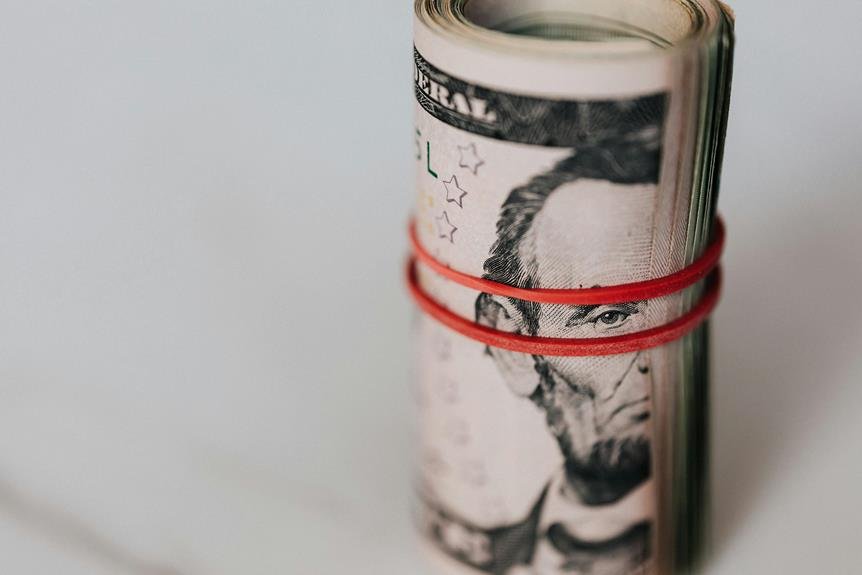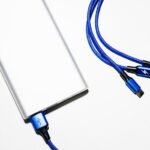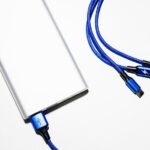To use a power bank for your iPhone 13, first make sure you've selected one with sufficient capacity and fast-charging capabilities, ideally with USB-C Power Delivery (PD). Confirm compatibility by checking the power output matches iPhone 13's requirements. Charge your power bank using a compatible, high-wattage charger for efficiency. Use a certified USB-C to Lightning cable, connecting one end to the power bank and the other to your iPhone. Monitor the charge status to prevent overcharging. Remember to store and maintain the power bank properly for longevity. If you're interested in more detailed tips, keep exploring for thorough guidance.
Choosing the Right Power Bank
When selecting the right power bank for your iPhone 13, it's important to think about factors such as battery capacity, charging speed, and compatibility to guarantee ideal performance and convenience. Power bank capacity is essential; you'll want a unit that can fully recharge your iPhone 13 at least once. For instance, a power bank with a capacity of 10,000mAh is generally sufficient for one to two full charges, ensuring you remain untethered from wall outlets.
Design options are another vital consideration. The market offers a variety of compact and lightweight models, which are perfect if you value portability. Some power banks even come with built-in cables, eliminating the need to carry extra accessories. Additionally, look for models that feature multiple ports if you plan to charge more than one device simultaneously.
Don't overlook the significance of fast-charging capabilities. Power banks with USB-C Power Delivery (PD) can charge your iPhone 13 much quicker than standard models. This is particularly useful when you're on the go and need a quick battery boost.
Checking Compatibility
Verifying that your selected power bank is compatible with the iPhone 13 involves checking both the power output specifications and the included cables or ports. Start by examining the voltage requirements of the iPhone 13. It typically needs a power source that provides a voltage of 5V and a current of 2A for efficient charging. Your power bank should meet or exceed these specifications to ensure effective and safe charging.
Next, consider the power bank size. A larger capacity power bank, measured in milliampere-hours (mAh), will allow for multiple charges of your iPhone 13. For example, a 10,000 mAh power bank can charge your iPhone 13 approximately two to three times, depending on usage.
Additionally, check the connectivity options. The iPhone 13 uses a Lightning cable, so your power bank should either come with a compatible Lightning cable or have a USB port that you can connect to your own cable. Some power banks even offer direct Lightning output, which can streamline the charging process.
Charging Your Power Bank
When charging your power bank, you'll need to select a compatible charger that matches its input specifications. It's important to understand the charging time estimates based on the power bank's capacity and the charger's output. Additionally, following safety precautions guarantees a longer lifespan for your device and prevents potential hazards.
Selecting Compatible Charger
Selecting an appropriate charger for your power bank is vital to guarantee peak charging efficiency and to extend the lifespan of both the power bank and your iPhone 13. The first aspect to take into account is the power bank features, specifically its input specifications. Most power banks will have their input voltage and current ratings displayed on the device or in the user manual. Making sure that your charger matches these ratings is essential for the best performance.
Charging speed is another crucial factor. A charger with a higher wattage will typically charge your power bank faster, but only if the power bank supports that level of input. For example, if your power bank supports 18W input charging, using an 18W or higher charger will maximize the charging speed. However, using a charger that exceeds the power bank's input capacity can lead to overheating or even damage.
Furthermore, take into consideration the type of charging port your power bank uses—whether it's USB-C, Micro-USB, or Lightning. Utilizing a charger with the correct port ensures a secure connection and efficient power transfer. By choosing a compatible charger, you're not just safeguarding your devices, but also ensuring you have the freedom to stay powered up wherever you go.
Charging Time Estimates
Calculating the charging time for your power bank involves understanding its capacity and the input power it receives from the charger. First, identify your power bank's battery capacity, typically measured in milliampere-hours (mAh). Common capacities range from 5,000 mAh to 20,000 mAh. Once you know this, you need to determine the charging speed, which relies on the input power rating of your charger, measured in watts (W) or amperes (A) at a specific voltage (V).
For instance, if your power bank has a battery capacity of 10,000 mAh and your charger provides 5V at 2A (equivalent to 10W), the calculation becomes straightforward. Divide the power bank's capacity by the charger's output power. Here's a simplified equation:
\[ ext{Charging Time (hours)} = rac{ext{Battery Capacity (mAh)}}{ext{Charging Speed (mA)}} \]
So, for a 10,000 mAh power bank with a 2,000 mA (2A) charger, the estimated charging time would be:
\[ rac{10,000 \, ext{mAh}}{2,000 \, ext{mA}} = 5 \, ext{hours} \]
However, real-world factors like power loss and efficiency can prolong this time. Understanding these elements guarantees you're ready to manage your power bank effectively, providing you the freedom to use your iPhone 13 without interruptions.
Safety Precautions
While estimating charging times is important, it's equally essential to follow safety measures when charging your power bank to prevent damage and secure longevity. First, make sure you're using the original or a certified charger. Non-certified chargers can overheat and harm the internal components.
Avoid charging your power bank on flammable surfaces. Charging generates heat and placing it on a heat-sensitive surface might pose fire risks. Additionally, don't leave your power bank unattended while charging. This helps you react promptly if any malfunction occurs.
One of the common mistakes users make is overcharging. Even though most power banks have built-in protection against overcharging, it's wise to unplug once it's fully charged. Overcharging can degrade the battery over time. Another key usage tip is to avoid using the power bank while it's charging. This can lead to overheating and reduce its lifespan.
Lastly, keep your power bank in a cool, dry place. Extreme temperatures can negatively affect battery performance. Don't expose it to direct sunlight or leave it inside a hot car. By following these safety measures, you'll guarantee your power bank remains reliable and efficient for your iPhone 13.
Connecting Your Iphone 13
To connect your iPhone 13 to a power bank, start by making sure you have a compatible USB-C to Lightning cable or adapter. This is essential for best charging efficiency and compatibility. Once you've got the right cable, plug the USB-C end into the power bank and the Lightning end into your iPhone 13. The connection should be immediate, and your iPhone will begin charging.
If you encounter any issues, such as your iPhone not charging, start troubleshooting connection issues by checking the cable and ports for debris or damage. Verify that the power bank is sufficiently charged and functioning correctly. Sometimes, simply unplugging and reconnecting the cable can resolve minor glitches.
For those who prefer a cable-free experience, wireless charging options are available. Confirm your power bank supports Qi wireless charging, which is compatible with iPhone 13. Position your iPhone on the power bank's charging pad, aligning it properly to start charging.
Monitoring Charge Status
You'll want to regularly check your iPhone 13's charge status to make sure it remains adequately powered throughout the day. Keeping an eye on your battery level is essential, especially when relying on a power bank. Your iPhone 13 provides built-in tools to help you monitor its battery status efficiently. You can see the battery percentage on the screen, enabling you to plan your charging needs better.
Consider setting up battery level alerts to notify you when your charge dips below a certain threshold. This can be particularly useful if you're often on the go and need to make sure you're never caught with a drained battery. Additionally, verify that your device is running the latest software updates. Apple frequently releases improvements that can optimize battery performance and provide more accurate notifications about your charge status.
Your iPhone 13 will also provide notifications when it's connected to a power source, including a power bank. This is an excellent way to confirm that your device is charging correctly. By staying informed about your battery level and setting up appropriate alerts, you can enjoy the freedom of using your iPhone 13 without constantly worrying about running out of power.
Maximizing Battery Life
Optimizing your iPhone 13's battery life involves implementing several strategies that can greatly extend its longevity and efficiency. To make sure you're getting the most out of your device, incorporating both battery saving tips and understanding power bank features is pivotal. Here are some expert-backed techniques:
- Enable Low Power Mode: This feature reduces background activity like downloads and mail fetching until you can fully charge your iPhone.
- Turn Off Unnecessary Services: Disabling Wi-Fi, Bluetooth, and Location Services when not in use can significantly preserve battery.
- Adjust Screen Brightness: Lowering your screen's brightness or enabling Auto-Brightness can prevent unnecessary battery drain.
- Update Software Regularly: Apple's software updates often include battery efficiency improvements, so keeping your iPhone up-to-date is necessary.
When using a power bank, select one with features that complement your iPhone 13 for long term usage. Look for power banks with high capacity (measured in mAh), fast charging capabilities, and multiple output ports for effectiveness. These features guarantee that your device charges quickly and that the power bank itself lasts a long time.
Implementing these efficiency techniques allows you to maximize battery life and maintain your iPhone 13's performance without compromising your freedom to use your device as desired.
Safety Tips and Maintenance
Maintaining the safety and proper upkeep of your power bank and iPhone 13 is vital for long-term efficiency and reliability. To start with, proper storage of your power bank is essential. Always store it in a cool, dry place away from direct sunlight and extreme temperatures. Excessive heat or cold can degrade the battery and reduce its lifespan. Additionally, avoid storing your power bank in damp or dusty environments, as moisture and dust can damage internal components.
Regular cleaning is another significant aspect. Use a soft, dry cloth to clean the exterior of your power bank and iPhone 13. Avoid using abrasive materials or harsh chemicals, which can scratch surfaces and damage ports. For the charging ports, a gentle brush or compressed air can help remove any debris that might obstruct charging.
Moreover, always use the original or certified charging cables to guarantee compatibility and safety. Faulty cables can lead to inefficient charging and potential damage. Lastly, refrain from overcharging your devices. Disconnect them once fully charged to prevent overheating and battery strain. By following these guidelines, you'll maintain the performance and longevity of both your power bank and iPhone 13, providing you the freedom to stay powered up on the go.
Frequently Asked Questions
Can I Use My Iphone 13 While It Charges With a Power Bank?
Yes, you can use your iPhone 13 while it charges with a power bank. This won't harm battery life and allows multitasking. It provides portability and convenience, letting you stay productive wherever you are.
How Long Does It Take to Fully Charge an Iphone 13 With a Power Bank?
The charging speed and battery capacity of your power bank determine how long it'll take to fully charge an iPhone 13. Typically, with a high-capacity, fast-charging power bank, you're looking at around 1.5 to 2 hours.
Are There Any Power Banks That Support Wireless Charging for Iphone 13?
Certainly, several power banks boast wireless compatibility for your iPhone 13. They provide charging efficiency and combine battery capacity with portability. Look for models like Anker's PowerCore or Mophie's PowerStation for best performance and convenience.
What Should I Do if My Power Bank Stops Working While Charging My Iphone 13?
If your power bank stops working while charging your iPhone 13, start with troubleshooting tips like checking connections and resetting the power bank. Common issues may need replacement options. Consider charging alternatives to maintain your freedom.
Can I Charge Other Devices Simultaneously With My Iphone 13 Using a Power Bank?
Yes, you can charge multiple devices simultaneously with a power bank. However, this may impact charging speed and efficiency. Confirm your power bank's compatibility with all devices to maintain peak performance and avoid potential issues.



